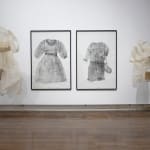-
Kyra Mancktelow
Jundal & Giba, 2021two handmade garments –
tarleton cloth and smoke from cleansing ceremony;
handmade Quandamooka traditional weave belt, woven from natural fibres;
handmade dilly bags, seashells and ochre collected from Quandamooka Country97 x 75 cm (girl)
87 x 75 cm (boy)Series: Moongalba III$ 10,000.00Further images
-
(View a larger image of thumbnail 1
)

-
(View a larger image of thumbnail 2
)

-
(View a larger image of thumbnail 3
)

-
(View a larger image of thumbnail 4
)

-
(View a larger image of thumbnail 5
)

-
(View a larger image of thumbnail 6
)

-
(View a larger image of thumbnail 7
)

-
(View a larger image of thumbnail 8
)

-
(View a larger image of thumbnail 9
)

-
(View a larger image of thumbnail 10
)

-
(View a larger image of thumbnail 11
)

-
(View a larger image of thumbnail 12
)

-
(View a larger image of thumbnail 13
)

In Kyra’s Moongalba’ series, the artist has recreated the 1896 Moongalba (Myora mission) garments forced upon the children to wear that signify the attempts of assimilation through the removal of...In Kyra’s Moongalba’ series, the artist has recreated the 1896 Moongalba (Myora mission) garments forced upon the children to wear that signify the attempts of assimilation through the removal of cultural identity via westernised domestication.
Myora was established as a mission station in 1892 in the colony of Queensland, at Moongalba on Minjerribah. After the four years under the strict missionary regime the members of the Myora community faced court which lead to the realise from the four year ordeal. It became an Aboriginal reserve and “industrial and reform school” after 1896 and closed in 1941.
‘These garments and prints investigate long-lasting legacies of colonialism, asking questions such as how we remember and acknowledge these histories. My hope is to draw upon the strength of resistance by adapting, retaining cultural ways and identity.’ -
(View a larger image of thumbnail 1
)
Art, events and ideas in your inbox.
We won't send you lots of emails. Promise.
* denotes required fields
We will process the personal data you have supplied in accordance with our privacy policy (available on request). You can unsubscribe or change your preferences at any time by clicking the link in our emails.












